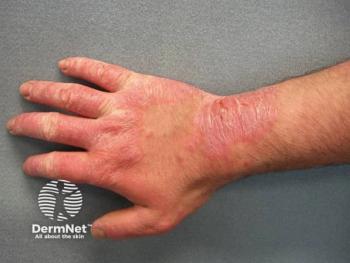
- Dermatology Times, January 2025 (Vol. 46. No. 01)
- Volume 46
- Issue 01
DFD-29: The Journey to FDA Approval and a New Era in Rosacea Management
Key Takeaways
- DFD-29 is the first oral therapy approved in the US for both erythema and inflammatory lesions in rosacea.
- Clinical trials showed DFD-29's superior efficacy and safety compared to doxycycline, with minimal adverse effects.
DFD-29, FDA-approved in 2024, revolutionizes rosacea management by addressing both erythema and inflammatory lesions with a novel extended-release formulation.
The FDA approval in November 2024 of 40-mg minocycline hydrochloride (Emrosi; Journey Medical Corporation), formerly known and hereafter referred to as DFD-29, marked a significant step forward in the treatment of rosacea.1
The approval of these 40-mg extended-release capsules represents the first time an oral, systemic therapy has been given the green light in the US to address both erythema and inflammatory lesions—2 hallmark symptoms of rosacea.2 Here, Dermatology Times looks back at DFD-29’s journey to approval and its future role in the rosacea treatment landscape.
A Look at the Past: The Evolution of Rosacea Therapies
Prior to the approval of DFD-29, only 4 drugs had received FDA approval for rosacea in the past decade3:
- December 2014: ivermectin (Soolantra; Galderma Laboratories, LP) cream, 1%4;
- January 2017: oxymetazoline hydrochloride (Rhofade; Allergan plc) cream, 1%5;
- May 2020: minocycline (Zilxi; Menlo Therapeutics Inc) topical foam, 1.5%6; and
- April 2022: benzoyl peroxide (Epsolay; Sol-Gel Technologies) cream, 5%.7
DFD-29: Journey to Approval
DFD-29’s path to FDA approval began with the submission of its new drug application in early 2024.6 Findings from the MVOR-1 (NCT05296629) and MVOR-2 (NCT05343455) clinical trials supported the application by demonstrating the efficacy and safety of DFD-29 in achieving primary and secondary end points.8 The results from these phase 3 studies showed significant improvements in patients’ Investigator Global Assessment scores, reductions in inflammatory lesions, and improvements in Clinician’s Erythema Assessment outcomes.7 Importantly, the trials reported minimal adverse events, with dyspepsia being the most common and occurring in only a small percentage of patients.1
The trials compared DFD-29 with 40-mg doxycycline (Oracea; Galderma Laboratories, LP)—the current standard-of-care treatment for rosacea—and found that the extended-release formulation of DFD-29 exhibited superior efficacy while maintaining a favorable safety profile.8
What Makes DFD-29 Unique?
DFD-29’s extended-release formulation is a key innovation. The steady delivery of DFD-29 helps mitigate fluctuations in drug levels, which can reduce adverse effects and improve tolerability. The dual efficacy in addressing inflammatory and vascular components of rosacea offers patients a streamlined therapeutic option, potentially reducing the need for additional treatments.9
This advancement also underscores the importance of tailoring systemic therapies to meet the multifaceted needs of patients with rosacea.10 In the MVOR trials, the drug showcased robust performance and tolerability1—which are crucial for patients managing a chronic condition.
“Emrosi showed great efficacy and tolerability in the pivotal clinical trials, and we are tremendously grateful to the patients, physicians, investigators, and site coordinators who participated and contributed to this important approval milestone,” said Srinivas Sidgiddi, MD, vice president of research and development at Journey Medical.1
Looking Toward the Future: The Impact of DFD-29 on Rosacea Treatment
The approval of DFD-29 signals a shift in the treatment paradigm for rosacea, with Emrosi anticipated to become the best-in-class oral therapy for the condition.1 DFD-29 is a novel option that combines efficacy with convenience, potentially simplifying treatment regimens for patients.9 Journey Medical anticipates a market launch in the first half of 2025,1 which will help address the growing demand for comprehensive and patient-centered rosacea therapies.11
Moreover, DFD-29’s approval reflects broader trends in dermatology: the emphasis on precision medicine, patient-centric care, and the development of therapies that address the unique pathophysiology of skin disorders.11 Future research may uncover new biomarkers or therapeutic targets, paving the way for even more tailored treatments.
References
- Journey Medical Corporation announces U.S. FDA approval of Emrosi (minocycline hydrochloride extended release capsules, 40 mg) for the treatment of rosacea. News release. Journey Medical Corp. November 4, 2024. Accessed December 3, 2024.
https://www.globenewswire.com/news-release/2024/11/04/2973917/0/en/Journey-Medical-Corporation-Announces-U-S-FDA-Approval-of-Emrosi-Minocycline-Hydrochloride-Extended-Release-Capsules-40-mg-for-the-Treatment-of-Rosacea.html - Journey Medical Corporation submitsnew drug application to FDA for DFD-29 to treat rosacea. News release. Journal Medical Corp. January 5, 2024. Accessed December 3, 2024.
https://ir.journeymedicalcorp.com/new-events/press-releases/detail/57/journey-medical-corporation-submits-new-drug-application-to - FDA approved treatments for rosacea. National Rosacea Society. Accessed December 3, 2024.
https://www.rosacea.org/patients/management-options/fda-approved-rosacea-treatments - Galderma receives FDA approval of novel treatment option for rosacea patients. News release. Galderma Laboratories LP. December 23, 2014. Accessed December 3, 2024.
https://www.galderma.com/us/news/galderma-receives-fda-approval-novel-treatment-option-rosacea-patients - Allergan announces FDA approval of Rhofade (oxymetazoline hydrochloride) cream, 1% for the topical treatment of persistent facial erythema associated with rosacea in adults. News release. Allergen plc. January 19, 2017. Accessed December 3, 2024.
https://www.prnewswire.com/news-releases/allergan-announces-fda-approval-of-rhofade-oxymetazoline-hydrochloride-cream-1-for-the-topical-treatment-of-persistent-facial-erythema-associated-with-rosacea-in-adults-300393385.html - Menlo Therapeutics receives FDA approval of Zilxi (minocycline) topical foam, 1.5%, the first topical minocycline treatment for rosacea. News release. Menlo Therapeutics Inc. May 29, 2020. Accessed December 3, 2024.
https://www.biospace.com/article/releases/menlo-therapeutics-receives-fda-approval-of-zilxi-minocycline-topical-foam-1-5-percent-the-first-topical-minocycline-treatment-for-rosaceazilxi-now-approved-for-inflammatory-lesions-of-rosacea-in-adults/ - Sol-Gel Technologies and Galderma announce FDA approval of Epsolay. News release. Sol-Gel Technologies Ltd. April 25, 2022. Accessed December 3, 2024.
https://www.globenewswire.com/news-release/2022/04/25/2427977/0/en/Sol-Gel-Technologies-and-Galderma-Announce-FDA-Approval-of-EPSOLAY.html - Journey Medical Corp announces positive topline results from its two phase 3 clinical trials (MVOR-1 and MVOR-2) evaluating DFD-29 for the treatment of papulopustular rosacea in adults. News release. Journey Medical Corp. July 11, 2023. Accessed December 3, 2024.
https://ir.journeymedicalcorp.com/new-events/press-releases/detail/47/journey-medical-corporation-announces-positive-topline - Journey Medical Corp announces DFD-29 data presented at 44th Fall Clinical Dermatology Conference. News release. Journey Medical Corp. October 25, 2024. Accessed December 3, 2024.
https://ir.journeymedicalcorp.com/new-events/press-releases/detail/74/journey-medical-corporation-announces-dfd-29-data-presented - Chen C, Wang P, Zhang L, et al. Exploring the pathogenesis and mechanism-targeted treatments of rosacea: previous understanding and updates. Biomedicines. 2023;11(8):2153. doi:10.3390/biomedicines11082153
- Del Rosso J, Baldwin H, Bhatia N, et al. A review of the diagnostic and therapeutic gaps in rosacea management: consensus opinion. Dermatol Ther (Heidelb). 2024;14(2):271-284. doi:10.1007/s13555-023-01087-8
Articles in this issue
10 months ago
Dermatology Times January 2025 Print Recap11 months ago
TikTok Hair Trends Explained11 months ago
Success Factors for Employed Dermatologists11 months ago
State-of-the-State Update: Chronic Hand Eczema11 months ago
Unveiling the Complexities of Atopic Dermatitis Care11 months ago
Introducing Dermatology Times’ 2025 Editor in ChiefNewsletter
Like what you’re reading? Subscribe to Dermatology Times for weekly updates on therapies, innovations, and real-world practice tips.



















